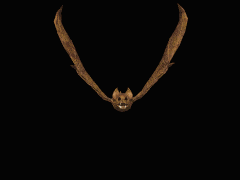 VAMPIRES
VAMPIRES
|
Vampires are mythological creatures who are described as undead beings who feed on the blood of humans. Although vampiric entities have been recorded in most cultures, the term vampire was not popularised until the early 18th century, after an influx of vampire folklore into Western Europe from Eastern Europe. In the Blade series however we also have what are called 'Daywalkers,' a vampire which, for various reasons, is immune to the effects of sunlight and is able to operate during the day Protection...... Apotropaics that is items able to ward off revenants, such as garlic, sunlight or holy water, feature commonly in vampire folklore. The items vary from region to region; a branch of wild rose and hawthorn bushels are said to harm vampires; in Europe, sprinkling mustard seeds on the roof of a house was said to keep vampires away. Other apotropaics include sacred items, for example a crusifix or rosary. Vampires are said to be unable to walk on consecrated ground, such as those of churches or temples, or across running water. In Asian legends, vampiric creatures are often warded off by holy devices such as Shinto seals. Aloe Vera hung backwards behind or near a door has the same function in South American superstition.Although not regarded as a vampire apotropaic, mirrors have been used to ward off vampires when placed facing outwards on a door. This attribute, although not universal as the Greek vrykolakas/tympanios was capable of both reflection and shadow, was utilized by Bram Stoker in Dracula and has since remained popular with subsequent authors and filmmakers. In addition to apotropaics, some traditions hold that a vampire cannot enter a house unless invited by the owner (Lost Boys), although they only have to be invited once as after this they can come and go as they please without further permission. Traditional methods of destroying vampires were varied, with staking the most commonly cited method, particularly in southern slavic cultures. (From Dusk Till Dawn). The preferred wood is ash in Russia and the Baltic states, or hawthorn in Serbia. Potential vampires were most often staked though the heart, though the mouth was targeted in Russia and northern Germany and the stomach in northeastern Serbia. The original folkloric revenants were described as bloated, thus the act of piercing the skin of the chest was a way of "deflating" the vampire; this is similar to the act of burying sharp objects, such as sickles, in with the corpse, so that they may penetrate the skin if the body bloats sufficiently whilst transforming into a revenant. Decapitation was the preferred method in German and western Slavic areas, with the head buried between the feet, behind the buttocks or away from the body. The act of cutting off the head was also seen as a way of hastening the departure of the soul from the body, which in some cultures, was said to linger in the corpse. The vampire's head, body or clothes could also be spiked and pinned to the earth to prevent rising. Gypsies drove steel or iron needles into a corpse's heart and placed bits of steel in the mouth, over the eyes, ears and between the fingers at the time of burial. They also placed hawthorn in the corpse's sock or drove a hawthorn stake through the legs. Further measures included pouring boiling water over the grave or complete incineration of the body. In the Balkans a vampire could also be killed by being shot or drowned, as well as having the funeral service repeated, by the sprinkling holy water on the body, or by exorcism. In Romania garlic could be placed in the mouth, and as recently as the 19th century, the precaution of shooting a bullet through the coffin was taken. For resistant cases, the body was dismembered and the pieces burned, mixed with water, and administered to family members as a cure. Even a lemon was placed in the mouth of suspected Saxon vampires in Germany.
|
![]() Copyright(C) 2007
- 2020. All rights reserved.
Copyright(C) 2007
- 2020. All rights reserved.
